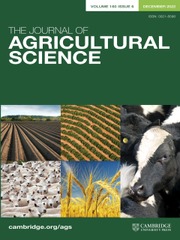Crossref Citations
This article has been cited by the following publications. This list is generated based on data provided by
Crossref.
Sutton, M
1995.
Assessment of the magnitude of ammonia emissions in the United Kingdom.
Atmospheric Environment,
Vol. 29,
Issue. 12,
p.
1393.
ORR, R. J.
PENNING, P. D.
PARSONS, A. J.
and
CHAMPION, R. A.
1995.
Herbage intake and N excretion by sheep grazing monocultures or a mixture of grass and white clover.
Grass and Forage Science,
Vol. 50,
Issue. 1,
p.
31.
JARVIS, S. C.
WILKINS, R. J.
and
PAIN, B. F.
1996.
Opportunities for reducing the environmental impact of dairy farming managements: a systems approach.
Grass and Forage Science,
Vol. 51,
Issue. 1,
p.
21.
Hutchings, N.J.
Sommer, S.G.
and
Jarvis, S.C.
1996.
A model of ammonia volatilization from a grazing livestock farm.
Atmospheric Environment,
Vol. 30,
Issue. 4,
p.
589.
Misselbrook, T.H.
Van Der Weerden, T.J.
Pain, B.F.
Jarvis, S.C.
Chambers, B.J.
Smith, K.A.
Phillips, V.R.
and
Demmers, T.G.M.
2000.
Ammonia emission factors for UK agriculture.
Atmospheric Environment,
Vol. 34,
Issue. 6,
p.
871.
Loubet, Benjamin
Milford, Celia
Sutton, Mark A.
and
Cellier, Pierre
2001.
Investigation of the interaction between sources and sinks of atmospheric ammonia in an upland landscape using a simplified dispersion‐exchange model.
Journal of Geophysical Research: Atmospheres,
Vol. 106,
Issue. D20,
p.
24183.
Ledgard, Stewart F.
2001.
Nitrogen cycling in low input legume-based agriculture, with emphasis on legume/grass pastures.
Plant and Soil,
Vol. 228,
Issue. 1,
p.
43.
Oenema, Oene
Bannink, André
Sommer, Sven G.
and
Velthof, Gerard L.
2001.
Nitrogen in the Environment: Sources, Problems and Management.
p.
255.
Bouwman, A. F.
Boumans, L. J. M.
and
Batjes, N. H.
2002.
Estimation of global NH3volatilization loss from synthetic fertilizers and animal manure applied to arable lands and grasslands.
Global Biogeochemical Cycles,
Vol. 16,
Issue. 2,
Dragosits, U
Theobald, M.R
Place, C.J
Lord, E
Webb, J
Hill, J
ApSimon, H.M
and
Sutton, M.A
2002.
Ammonia emission, deposition and impact assessment at the field scale: a case study of sub-grid spatial variability.
Environmental Pollution,
Vol. 117,
Issue. 1,
p.
147.
Külling, D.R.
Menzi, H.
Sutter, F.
Lischer, P.
and
Kreuzer, M.
2003.
Ammonia, nitrous oxide and methane emissions from differently stored dairy manure derived from grass- and hay-based rations.
Nutrient Cycling in Agroecosystems,
Vol. 65,
Issue. 1,
p.
13.
Leach, K. A.
Allingham, K. D.
Conway, J. S.
Goulding, K. W.T.
and
Hatch, D. J.
2004.
Nitrogen Management for Profitable Farming with Minimal Environmental Impact: The Challenge for Mixed Farms in the Cotswold Hills, England.
International Journal of Agricultural Sustainability,
Vol. 2,
Issue. 1,
p.
21.
Bolan, Nanthi S
Saggar, Surinder
Luo, Jiafa
Bhandral, Rita
and
Singh, Jagrati
2004.
Advances in Agronomy Volume 84.
Vol. 84,
Issue. ,
p.
37.
Dahlin, A.S.
Emanuelsson, U.
and
McAdam, J.H.
2005.
Nutrient management in low input grazing–based systems of meat production.
Soil Use and Management,
Vol. 21,
Issue. s1,
p.
122.
Dahlin, A.S.
Emanuelsson, U.
and
McAdam, J.H.
2005.
Nutrient management in low input grazing‐based systems of meat production.
Soil Use and Management,
Vol. 21,
Issue. 1,
p.
122.
Oenema, O.
Bannink, A.
Sommer, S.G.
Van Groenigen, J.W.
and
Velthof, G.L.
2008.
Nitrogen in the Environment.
p.
395.
Mulvaney, R. L.
2015.
Nitrogen in Agricultural Systems.
p.
437.
Blackwell, Martin S.A.
Jarvis, Steve C.
Wilkins, Roger J.
Beaumont, Deborah A.
Cardenas, Laura M.
Chadwick, David R.
Collins, Adrian L.
Dungait, Jennifer A.J.
Gibb, Malcolm J.
Hopkins, Alan
Lee, Michael R.F.
Misselbrook, Tom H.
Murray, Philip J.
and
Tallowin, Jerry R.B.
2018.
Vol. 149,
Issue. ,
p.
161.
Oliveira, Matheus Dias
Sousa, Fernanda Campos
Saraz, Jairo Osorio
Calderano, Arele Arlindo
Tinôco, Ilda Fátima Ferreira
and
Carneiro, Antônio Policarpo Souza
2021.
Ammonia Emission in Poultry Facilities: A Review for Tropical Climate Areas.
Atmosphere,
Vol. 12,
Issue. 9,
p.
1091.
Wu, L.
Harris, P.
Misselbrook, T.H.
and
Lee, M.R.F.
2022.
Simulating grazing beef and sheep systems.
Agricultural Systems,
Vol. 195,
Issue. ,
p.
103307.

